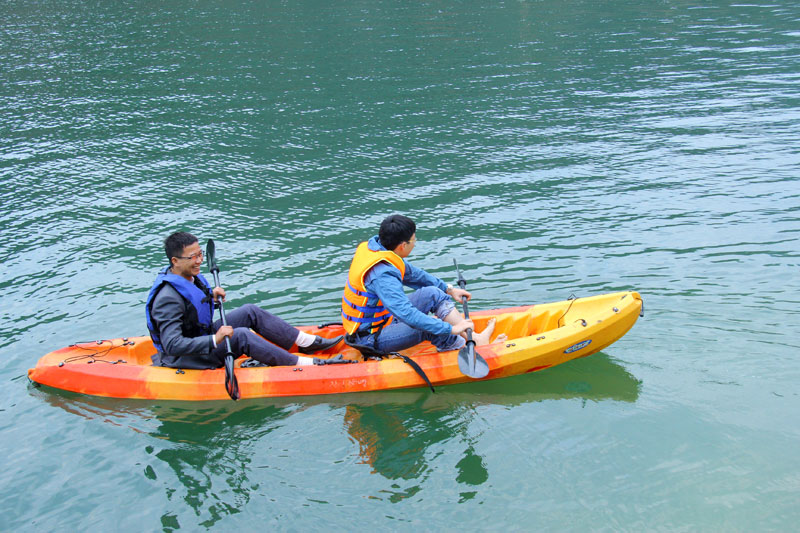
(HBO) – The Prime Minister on August 1 issued Decision No.1528/QD-TTg approving the master plan on developing the national Hoa Binh lake tourist area in the northern province of Hoa Binh until 2030.

Rowing on Hoa Binh lake in Da Bia village,
Tien Phong commune, Da Bac district
The province is devising specific plans to realise the master plan, which is
important to its tourism development, including rallying all possible resources
to fully tap potentials of Hoa Binh lake until 2025. As scheduled by 2030, the
area will boast synchronous and modern technical infrastructure and offer
high-quality and diverse tourist products, becoming the largest tourist area in
the province and one of the 12 key tourist areas in the northern mid-land and
mountainous region with cultural tours of the Muong ethnic group and the lake’s
ecological system as key products.
It plans to develop spiritual tours of Thac Bo temple in Cao Phong and Da Bac
district and Doi Co temple in Hien Luong commune, Da Bac district; build
quality resorts and ecological products on Sung island, Thien Phong commune, Da
Bac district; Ngoi Hoa bay in Ngoi Hoa commune, Tan Lac district;
community-based tourist products in Ngoi village in Ngoi Hoa commune, Tru
village in Thai Thinh commune, Ke village in Hien Luong commune, Da Bia village
in Tien Phong commune; as well as cultural tours in ethnic minority
communities.
Hoa Binh will continue tapping cruise tours from Tuan Chau tourist port in the
northern province of
Quang Ninh to Hoa Binh lake, and from Da Lake to Hoa Binh lake and hydropower
reservoirs in Son La, Dien Bien and Lai Chau provinces. Priority will be given
to home-stay services in community-based tourist villages and premier resort
services on nearly 1,000ha of Hoa Binh lake in Ngoi Hoa commune and Sung
island, 3-5 starred hotels in Thai Binh and Thai Thinh districts, and a
floating resort in Binh Thanh – Vay Nua – Hien Luong area, a food street and
cultural market along the two banks of the Da river, several stopovers with
artificial landscapes for visitors to take pictures, as well as signature
souvenirs.
It is encouraging businesses and investors to develop tourism by building and
upgrading cruise liners and using technological advances to develop competitive
tourist products.
A diverse chain of eco-tourism and resort destinations concentrated in Hoa Binh city and the districts of Tan Lac, Da Bac, and Luong Son… Along with the launch of several key high-quality resort tourism projects, these developments have reshaped the landscape and enhanced the appeal of Hoa Binh as a travel destination.
Boasting diverse terrain, a mild climate, and rich natural resources, Cao Phong district is increasingly asserting its place on Vietnam’s tourism map, attracting both domestic and foreign visitors. The district is renowned for its stunning landscapes, majestic mountains, a crystal-clear hydropower lake, and the unique cultural identity of local ethnic groups.
With its pristine landscapes, unique cultural heritage of Muong ethnic minority, and an expanding range of visitor experiences, Tan Lac district of Hoa Binh has fast become a captivating destination for both domestic and international tourists.
Until now, Sung village in Cao Son commune, Da Bac district remains the only Dao ethnic community in Hoa Binh province to develop a community-based tourism model. Beyond its untouched natural landscapes, cultural identity serves as the cornerstone attraction for visitors.
Alongside the diverse cultural identities of the Kinh, Muong, Tay, Thai, Dao, and Mong ethnic people, Hoa Binh province is also renowned as the "capital" of the northwestern Vietnamese cuisine, offering unique and distinctive dishes. At festivals, during Lunar New Year (Tet), or on significant family or community occasions, special dishes are prepared, leaving a lasting impression on visitors.
A Phong Linh (Yellow Tabebuia) flower garden in Thang village, Thach Yen commune, Cao Phong district is currently in full bloom, drawing a large number of visitors.



